When the first diamond frame bicycles became popular in the 1890s they were often called "wheels" - the national cycling association was called the "League of American Wheelmen." We have moved from "wheels" to "bikes," but the bicycles have remained remarkably the same over more than 100 years - elegant in their efficiency and simplicity. And many of the issues that we think are new? They were around then too.
Wednesday, January 17, 2018
Absurd Instructional Video on How/Where to Park a Dockless Bikeshare Bike
Let's just make a joke out of it then it will be ok
The LimeBike people seem to think this is a helpful gesture towards getting their users to park their bikes appropriately. It includes several "do this" and "don't do that" points.
It is worth noting that the LimeBike User Agreement has this minimalist statement: Upon conclusion of your ride, the Bike must be parked at a lawful parking spot, i.e. the Bike cannot be parked on private property or in a locked area or in any other non-public space.
The video suggests that what is needed beyond "lawful" parking is to show good "parking etiquette." For example, do not lay the bike on the ground, but do park at a bike rack. Do not block driveways or pedestrian paths, do park "in this zone" - which is shown as the parking strip next to the roadway that in residential areas in particular is often grass or dirt. Do not park at bus stops or street corners, but do park next to a bus stop.
After listening to this the two main characters launch themselves into the sky leaving their bike on the path - whether this falls under "blocking a pedestrian path" or not is unclear. The don't stay to clarify.
In Washington DC at least, some of this gets a little ... complicated. What is a lawful place to park? Since I have observed the U.S. Park Police carrying away dockless bikes parked up near the Washington Monument (before it was recently closed off to everyone) apparently they aren't too thrilled with them on NPS territory, period.
The kind of "zone" that is shown as ideal isn't necessarily all that common around here. What is best is to park them at bike racks, but there simply aren't enough of them.
Hmm.
Saturday, January 6, 2018
A Great Cycling Comedy? Jour de Fête
Trailer-like video for the re-release of a restored version of this 1948 movie in 2014 - embedded video starts where cycling is featured
Jacques Tati was a film director and actor in France after World War II up through the early 1960s. His films are quite remarkable, making certain social commentary in films that were mostly physical and visual humor (although it is more complex than that).
His first 1949 full length film, Jour de fête (or The Big Day), centers on a postman in a French village who spends much of the film making deliveries (although I have only seen snippets, not the entire thing). Wikipedia has a short summary of the plot. Apparently the thought was he should perform more like the (then) super-efficient United States Post Office.
Two minute clip where the postman joins French racing cyclists on the road
It is not clear to me in the above scenes how he manages to appear to maintain such a high rate of speed; perhaps the playback is sped up somehow, although it doesn't look that way when he is with the other riders. Sitting bolt upright as he is, it would be hard to maintain such speed, particularly given what seems to be a single-speed bike and how it appears to be geared.
The postman chases his bicycle that travels a considerable distance without a rider
Again, I don't know how they did this - keeping the bike rolling for these distances without falling over. I like that the pedals keeping going around, as they would on a fixed gear bike.
Friday, January 5, 2018
The Evolution of the Bicycle as a Tool-for-Living
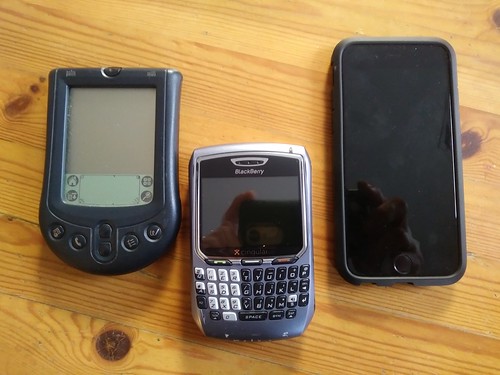
A point of comparison - 15 years (or so) of mobile computing devices
One reason I appreciate bicycles is that a good basic bicycle can be highly useful even if only slightly evolved from what was in use over 100 years ago.
By comparison, we have mobile computing devices, which are disposable units (although we see uhm I forgot to dispose of several) that provide useful service for at best four or five years. Further, while mobile commuting are evolving, not all the evolution is in a positive direction for many users. The 2001 (or so) Palm Pilot M105 was a cheap plastic device that required docking with a PC in order to upload/download messages but it weighed almost nothing and having no glass, was difficult to break (and if you did, it was so cheap, it didn't matter that much). I was actually fairly good with the "shorthand" to enter text with a stylus. The next step, a "traditional" 2005 or 2006 BlackBerry, was much more truly a mobile computing device but best for doing email with its "real" (tiny) keyboard - the size of the screen made Internet browsing painful - but then, that wasn't the point. Then we have a now-old(ish) iPhone 6 - the main thing I use it for is email, for which the keyboard is not great (for me; I realize some are good at it). The browser is good but not the main reason I have this device. And compared to the Palm Pilot or the BlackBerry, it is heavier as well as fragile with its sheet of glass. (Alas now I find it necessary some of the time to have both a work phone and a personal phone and the two of them together weigh 5/6 of a pound, which is annoying.)
Most importantly the two older mobile devices are simply unusable due to obsolescence. There is no comparison with a good bicycle!
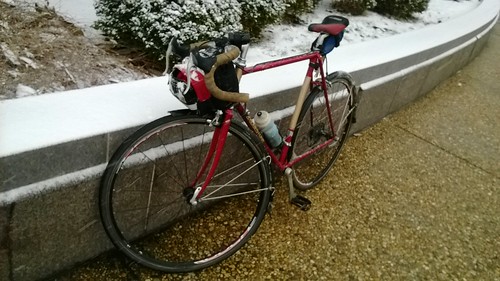
A 1982 Bridgestone bicycle that I ride thousands of miles a year to and from work
About six years ago I bought the frame and fork for this Bridgestone on eBay for a little over $100 including the shipping. I then spent another ~$400 on a combination of used and new components to make it into an outstanding commuter bike. Other than the brakes I chose, which are a design introduced in the 1990s, nothing about the bike now represents a technological improvement over the bike as originally sold in 1982. I would be fine with riding the bike to and from work with the components that it had originally - that is, there is no way to regard any aspect of this bike as sold 35 years ago as obsolete. No one gives a second glance to this bicycle as they would if I tried to use my plastic Palm Pilot at a meeting at work, for example, or to use a different example, if I drove around in a 35 year old car.
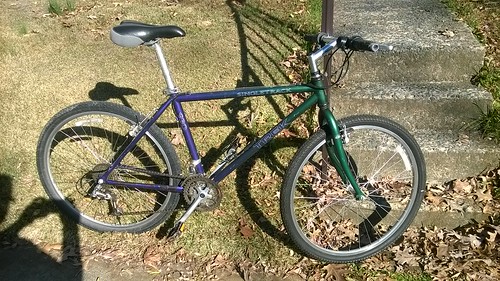
Another ageless bicycle, a 1995 Trek SingleTrack
I purchased this bike two years ago from a bike repair "collective" (http://velocitycoop.org/ that had too many bikes and was selling excess - it cost $60 more or less as shown, except it was missing a saddle (seat) and only had one pedal. Well and it was incredibly filthy. I added a pedal and saddle and cleaned it and it was immediately ridable. While at the time this was a "low end" Trek bike, it was still significantly more expensive than many similar looking bikes one sees for sale today - the difference was that this bike was made with well thought out double butted chromoly tubing for the frame that means it only weighs 27 pounds (which is good). I have put studded tires on this for winter and it is a great bike for icy conditions!
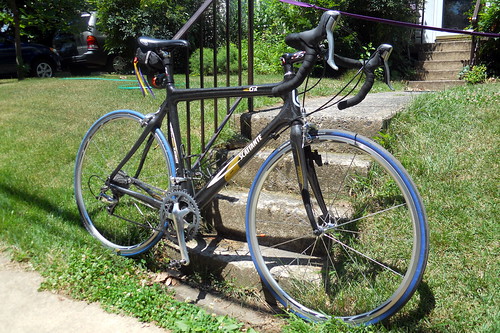
My one perhaps mistaken concession to modern bicycle technology - sort of
I did buy this bike new in 2007 - it is a carbon fiber road bike and I ride it in good weather. Avoiding rain reduces maintenance and the bike doesn't have fenders anyway. It is nice, weighs just under 20 pounds, or about five pounds less than the Bridgestone above. The "technology" that is advanced for this bike is the use of carbon fiber for the frame, which at the time had a certain appeal to me that I still understand, but I wouldn't do it again. Carbon fiber is simply nasty to dispose of, although apparently the bike frame is unlikely to wear out - but eventually someone will dispose of it. And creating it in the first place was not a green process, either. Carbon fiber bike frames didn't render my steel bikes obsolete for commuting!
I doubt I will ever buy another new bicycle. New to me, perhaps, but not new-new. New technologies for bicycles are largely optional (if not also perhaps highly attractive/sexy to some people) such as hydraulic brakes or electronic shifting. No thanks.
Thursday, January 4, 2018
Unusual Bicycle Messenger Photograph
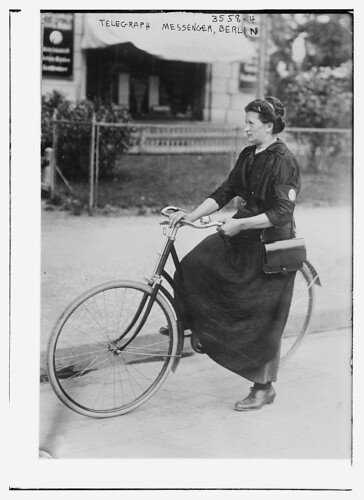
Telegraph messenger, Berlin - during WWI
http://hdl.loc.gov/loc.pnp/ggbain.19641 persistent link to this Library of Congress collection item, a digitized Bain News Service photograph.
Bicycle messengers in the US 100 years ago or so were usually teenage boys, hardly old enough to serve in the army, but apparently in Berlin this was not the case since with the men off serving, this woman was a bicycle messenger. Her attire, with long skirt, is not particularly practical for this activity (but it could have been worse). Her single-speed bicycle with a simple spoon brake with a step-through frame is probably not inferior to a mens that would have been used for this purpose at the time.
Presumably this photograph was taken before the United States joined the war against Germany.
Wednesday, December 27, 2017
"A Celebration of Cycling"-Statue

Happy New (Cycling) Year!
Artist Jerome B. Meadows's 1991 sculpture, "A Celebration of Bicyling," stands on the grounds of Carillon Historical Park in Dayton, Ohio, that contains historic buildings and exhibits concerning the history of technology and the history of Dayton. One of the reasons that the city celebrates cycling is that the pioneer aviators Orville and Wilbur Wright operated several cycling shops in town while they worked to perfect their historic flying machine.
Title
Artist Jerome B. Meadows's 1991 sculpture, "A Celebration of Bicycling," stands on the grounds of Carillon Historical Park in Dayton, Ohio, that contains historic buildings and exhibits concerning the history of technology and the history of Dayton
Contributor Names-Highsmith, Carol M., 1946-, photographer
Created / Published-2016-10-12.
Subject Headings
- United States--Ohio--Montgomery County--Dayton
- America
- Jerome B. Meadows
- Celebration of Bicycling sculpture
- Carillon Historical Park
- Wright brothers
- Orville Wright
- Wilbur Wright
Format Headings-Digital photographs--Color--2010-2020.
Genre-Digital photographs--Color--2010-2020
Notes
- Title, date and keywords based on information provided by the photographer.
- One of the reasons that the city celebrates cycling is that the pioneer aviators Orville and Wilbur Wright operated several cycling shops in town while they worked to perfect their historic flying machine.
- Credit line: Photographs in the Carol M. Highsmith Archive, Library of Congress, Prints and Photographs Division.
- Purchase; Carol M. Highsmith Photography, Inc.; 2016; (DLC/PP-2016:103-4).
- Forms part of the Carol M. Highsmith Archive.
Medium-1 photograph : digital, tiff file, color.
Call Number/Physical Location-LC-DIG-highsm- 41750 (ONLINE) [P&P]
Source Collection-Highsmith, Carol M., 1946- Carol M. Highsmith Archive.
Repository=-Library of Congress Prints and Photographs Division Washington, D.C. 20540 USA hdl.loc.gov/loc.pnp/pp.print
Digital Id-highsm 41750 //hdl.loc.gov/loc.pnp/highsm.41750
Library of Congress Control Number-2016632568
Subscribe to:
Comments (Atom)